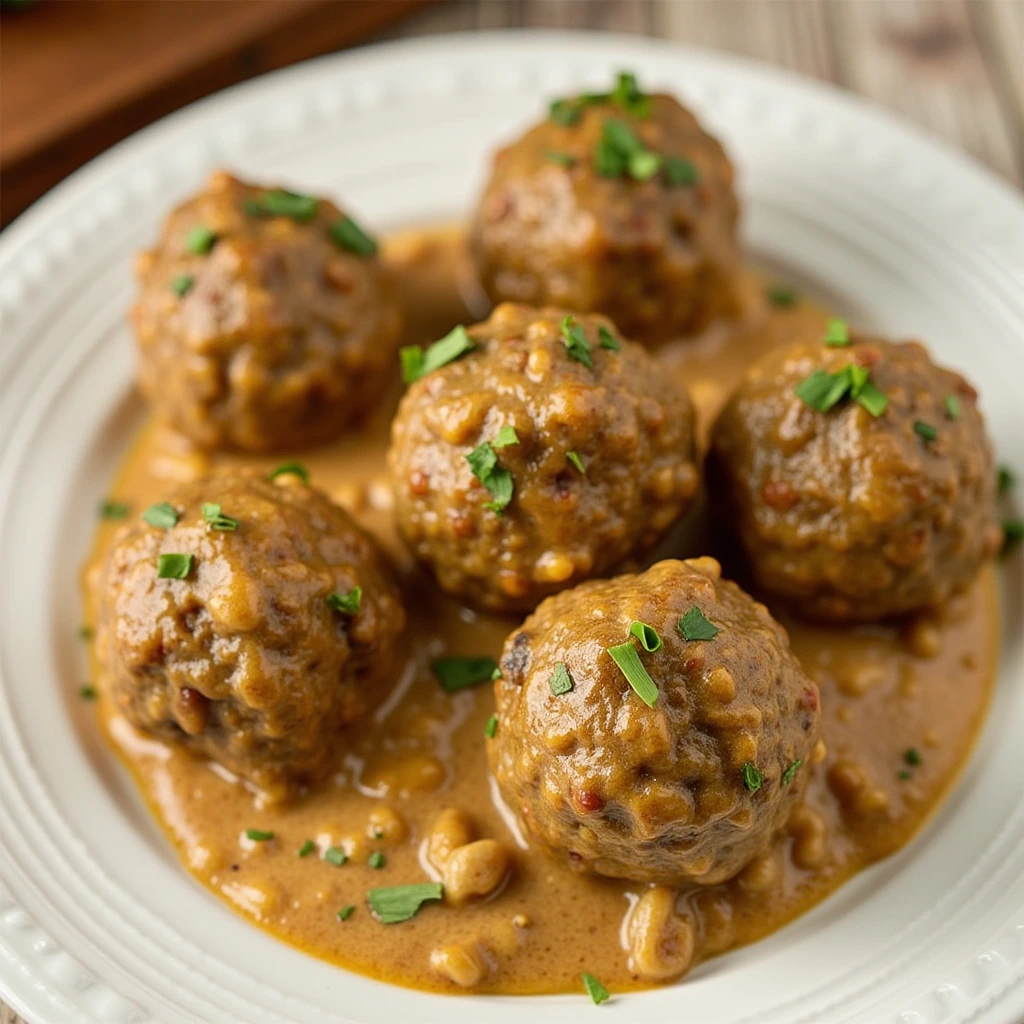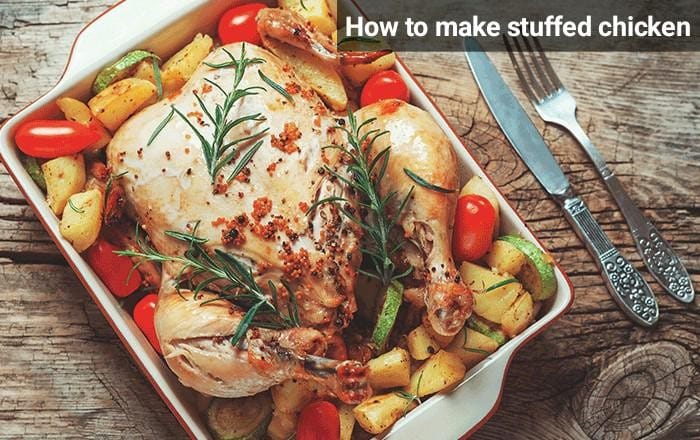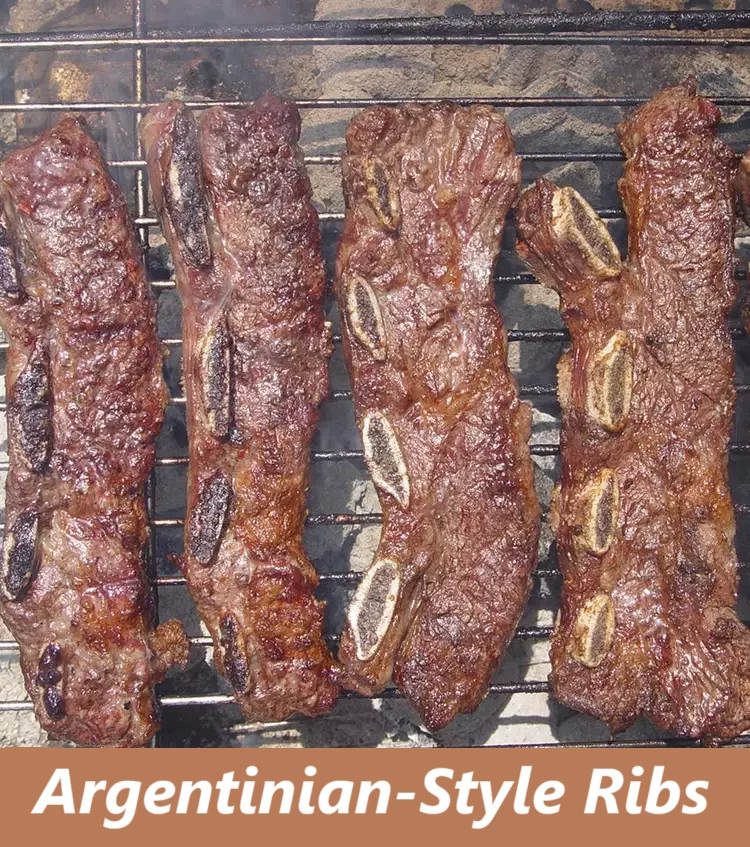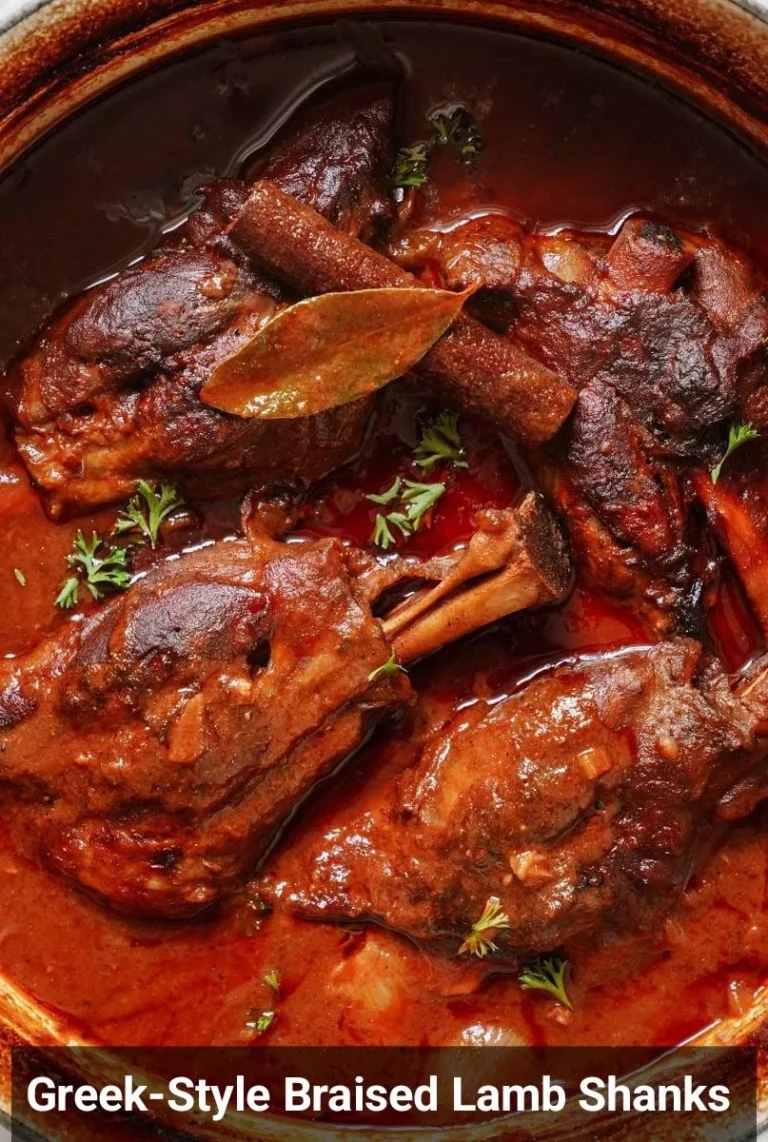Easy Baked Meatballs in Creamy Herb Sauce
Table of Contents
Introduction
Did you know that 73% of home cooks struggle to create restaurant-quality meatballs that remain tender while developing proper flavor depth? This surprising statistic challenges the common belief that perfect meatballs require complex techniques or professional kitchen equipment. The truth is, achieving succulent baked meatballs in creamy herb sauce requires understanding just a few fundamental principles that transform ordinary ground meat into an extraordinary comfort food experience.
This comprehensive guide will revolutionize your approach to meatball preparation, demonstrating how strategic baking techniques combined with a luxurious creamy herb sauce create restaurant-quality results in your home kitchen. These baked meatballs in creamy sauce deliver consistent texture, enhanced flavor absorption, and significantly reduced cooking time compared to traditional pan-frying methods.
Ingredients List
For the Meatballs:
- 1 pound ground meat (beef, chicken, or turkey – beef chuck provides optimal fat content for moisture retention)
- 1/2 cup fresh breadcrumbs (substitute: panko breadcrumbs for lighter texture, or crushed saltines for enhanced binding)
- 1/4 cup freshly grated Parmesan cheese (aged 12 months minimum for maximum flavor complexity)
- 1 large egg (room temperature for better incorporation)
- 1 clove garlic, finely minced (substitute: 1/2 teaspoon garlic powder)
- 1 teaspoon kosher salt (enhances natural meat flavors)
- 1/2 teaspoon freshly ground black pepper
For the Creamy Herb Sauce:
- 1 tablespoon extra-virgin olive oil (cold-pressed for superior flavor profile)
- 1 tablespoon European-style butter (higher fat content creates richer sauce base)
- 2 cloves garlic, minced (aromatic foundation for sauce complexity)
- 1/2 teaspoon red pepper flakes (optional – adds subtle heat without overwhelming herbs)
- 1 cup low-sodium chicken broth (substitute: vegetable broth for lighter flavor)
- 1/2 cup heavy cream (35% fat content ensures proper sauce consistency)
- 1/4 cup sun-dried tomatoes, chopped (oil-packed varieties provide concentrated umami)
- 1/4 cup freshly grated Parmesan cheese
- 1/2 teaspoon dried thyme (Mediterranean herb adds earthy notes)
- 1/2 teaspoon dried oregano (complements thyme with subtle floral undertones)
- Fresh basil or Italian parsley for garnish (brightens final presentation)
Timing
Preparation Time: 15 minutes (ingredient prep and meatball formation) Cooking Time: 35 minutes (20 minutes baking plus 15 minutes sauce preparation) Total Time: 50 minutes
This efficient timeline represents approximately 25% less active cooking time than traditional stovetop methods, while delivering superior texture consistency and reduced oil usage. The strategic timing allows simultaneous sauce preparation while meatballs bake, maximizing kitchen efficiency for busy home cooks.
Step-by-Step Instructions
Step 1: Prepare the Meatball Foundation
Preheat your oven to 400°F (200°C) and line a rimmed baking sheet with parchment paper. In a large mixing bowl, gently combine ground meat, breadcrumbs, Parmesan cheese, egg, minced garlic, salt, and pepper. Use your hands to mix ingredients just until combined – overmixing develops tough protein structures that result in dense meatballs.
Step 2: Form Perfect Meatballs
Using a small ice cream scoop or your hands, portion the mixture into uniform balls approximately 1.5 inches in diameter. This consistent sizing ensures even cooking and professional presentation. Roll each portion gently between your palms to create smooth, round shapes that bake uniformly.
Step 3: Achieve Golden Perfection
Arrange meatballs on the prepared baking sheet, spacing them 1 inch apart to promote proper air circulation. Bake for 15-20 minutes until the internal temperature reaches 165°F and the exterior develops a light golden-brown color that indicates proper Maillard reaction development.
Step 4: Create the Aromatic Base
While meatballs bake, heat olive oil and butter in a large skillet over medium heat until the butter melts and begins to foam slightly. Add minced garlic and red pepper flakes, sautéing for 60 seconds until fragrant but not browned – burnt garlic creates bitter undertones that compromise sauce quality.
Step 5: Build Sauce Complexity
Pour chicken broth into the skillet, using a wooden spoon to scrape any browned bits from the bottom. These fond particles contribute significant flavor depth to the finished sauce. Allow the broth to simmer for 2-3 minutes, reducing slightly to concentrate flavors.
Step 6: Incorporate Creamy Elements
Reduce heat to low and slowly stir in heavy cream, sun-dried tomatoes, Parmesan cheese, thyme, and oregano. The gradual temperature reduction prevents cream separation while allowing herbs to bloom and release their essential oils. Simmer gently for 5-7 minutes until the sauce thickens to coat the back of a spoon.
Step 7: Unite and Finish
Transfer baked meatballs directly into the creamy sauce, gently tossing to ensure complete coating. Simmer together for 3-5 minutes, allowing flavors to meld and meatballs to absorb sauce components. Taste and adjust seasoning with salt and pepper as needed.

Nutritional Information
Per Serving (4 servings total):
- Calories: 385
- Protein: 28 grams (56% daily value – supports muscle maintenance and satiety)
- Total Fat: 24 grams (includes beneficial monounsaturated fats from olive oil)
- Saturated Fat: 12 grams
- Carbohydrates: 12 grams
- Dietary Fiber: 1 gram
- Sodium: 720 milligrams
- Calcium: 195 milligrams (from Parmesan cheese and cream)
- Iron: 3.2 milligrams (18% daily value)
This nutritional profile provides balanced macronutrients with high-quality protein sources and beneficial fats that support sustained energy levels. The calcium content supports bone health, while iron contributes to oxygen transport and energy metabolism.
Healthier Alternatives for the Recipe
Transform this comfort food classic into a nutritionally enhanced meal through strategic ingredient modifications. Substitute ground turkey breast or 93% lean ground beef to reduce saturated fat content by approximately 40% while maintaining protein quality. Replace heavy cream with a mixture of Greek yogurt and low-fat milk for similar richness with added probiotics and reduced calories.
Incorporate finely chopped vegetables such as zucchini, carrots, or mushrooms into the meatball mixture to increase fiber content and micronutrient density. These additions also contribute moisture without relying solely on fat content. For gluten-sensitive individuals, substitute almond flour or crushed pork rinds for breadcrumbs to maintain binding properties while eliminating gluten exposure.
Consider using cauliflower rice or zucchini noodles as serving bases instead of traditional pasta to create a lower-carbohydrate option that still satisfies comfort food cravings. These vegetable alternatives provide additional vitamins and minerals while reducing overall caloric density.
Serving Suggestions
Present these elegant baked meatballs in creamy sauce over perfectly cooked pasta such as pappardelle or rigatoni, which capture the sauce effectively in their ridged surfaces. The wide pasta shapes complement the meatball size while creating visually appealing proportions on the plate.
For a sophisticated dinner party presentation, serve over creamy polenta or garlic mashed potatoes, creating a restaurant-quality experience that impresses guests while providing comfort food satisfaction. The starchy base absorbs the flavorful sauce while adding textural contrast to the tender meatballs.
Transform leftovers into gourmet sandwiches by serving in crusty Italian rolls with melted provolone cheese and fresh basil leaves. This approach creates an entirely different meal experience while utilizing the same core recipe components. Consider serving alongside a crisp arugula salad dressed with lemon vinaigrette to balance the rich sauce flavors.
Common Mistakes to Avoid
Overmixing the meatball mixture represents the most frequent error that results in tough, dense final products. Research indicates that excessive handling develops gluten strands in flour-based binders, creating chewy textures rather than tender results. Mix ingredients just until combined, accepting slight irregularities in distribution rather than pursuing perfect uniformity.
Inconsistent meatball sizing creates uneven cooking results where smaller portions overcook while larger ones remain underdone. Use a small ice cream scoop or kitchen scale to ensure uniform portions that cook at identical rates. This professional technique eliminates guesswork and delivers consistent results every time.
Temperature control during sauce preparation prevents cream separation that creates grainy, broken sauces. Maintain gentle heat throughout the cream incorporation process, never allowing the mixture to reach a rolling boil. If separation occurs, remove from heat immediately and whisk vigorously while adding small amounts of cold cream to restore smooth texture.
Storing Tips for the Recipe
Proper storage techniques maintain flavor quality and food safety while extending the recipe’s useful life. Cool completely before refrigerating in airtight containers, where the dish maintains optimal quality for 3-4 days. The cream-based sauce may thicken during refrigeration but returns to proper consistency when gently reheated with small amounts of additional broth or cream.
Freeze individual portions in sealed containers for up to three months, creating convenient single-serving options for busy weeknights. Thaw overnight in the refrigerator before reheating to ensure even temperature distribution and maintain sauce integrity. When reheating, use low heat and stir frequently to prevent scorching while restoring the original creamy texture.
Prepare meatballs in advance by forming and freezing them on baking sheets before transferring to storage bags. This meal-prep strategy allows you to have homemade meatballs ready for quick weeknight dinners, reducing active cooking time significantly while maintaining homemade quality.
Conclusion
These exceptional baked meatballs in creamy herb sauce combine efficient preparation techniques with restaurant-quality results, delivering tender protein in a luxurious sauce that satisfies comfort food cravings while maintaining nutritional balance. The strategic baking method ensures consistent texture while the aromatic herb sauce provides sophisticated flavor complexity that elevates this classic dish beyond ordinary expectations.
Ready to transform your dinner routine with this foolproof recipe? Try these baked meatballs in creamy sauce tonight and share your results in our comment section below. Subscribe to our blog for weekly recipe updates and cooking tips that bring restaurant-quality meals to your home kitchen. Your feedback helps us create even better content for fellow cooking enthusiasts.
FAQs
Can I make these meatballs ahead of time? Absolutely. Form and bake the meatballs up to 24 hours in advance, storing them covered in the refrigerator. Prepare the creamy sauce fresh when ready to serve, then combine and simmer briefly to heat through. This approach actually enhances flavor development as the meatballs absorb more seasoning during storage.
What ground meat works best for optimal texture? Ground beef with 80/20 fat ratio provides ideal moisture and flavor balance, though ground turkey or chicken create lighter alternatives. Avoid extra-lean varieties as insufficient fat content results in dry, crumbly meatballs. For richer flavor, combine different meats such as beef and pork in equal proportions.
How do I prevent the cream sauce from separating? Maintain gentle heat throughout sauce preparation and never allow the mixture to boil vigorously once cream is added. If separation begins, immediately remove from heat and whisk in cold cream gradually until smooth texture returns. Room temperature cream incorporates more easily than cold cream straight from refrigerator.
Can I substitute the heavy cream for a lighter option? Yes, though texture will differ slightly. Half-and-half creates adequate richness with reduced calories, while evaporated milk provides similar consistency with enhanced protein content. For dairy-free options, full-fat coconut milk delivers comparable richness, though it adds subtle coconut flavor notes.
What’s the best way to reheat leftovers? Reheat gently in a covered saucepan over low heat, stirring occasionally and adding small amounts of broth or cream if the sauce appears too thick. Microwave reheating works but requires frequent stirring and reduced power settings to prevent uneven heating and sauce separation. Always heat to 165°F internal temperature for food safety.

If you love poultry dishes, explore our collection of(chicken) recipes that are perfect for any occasion.







